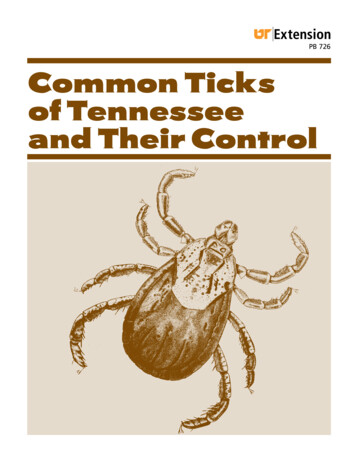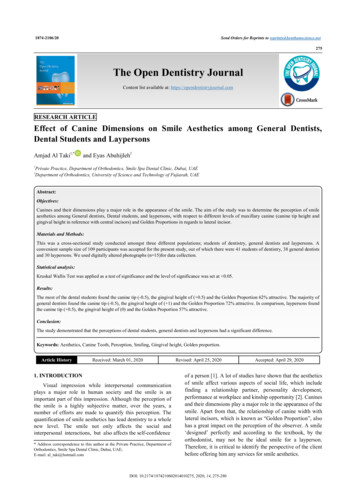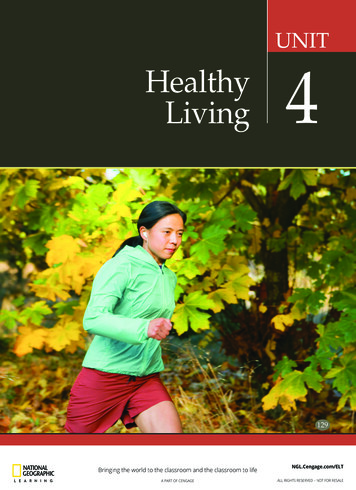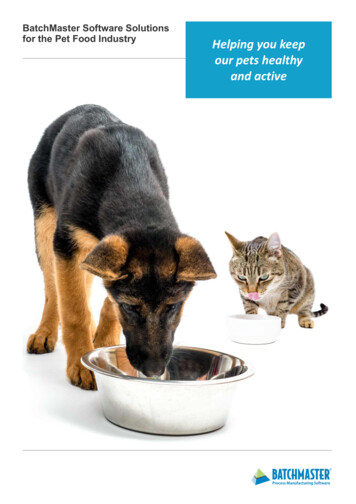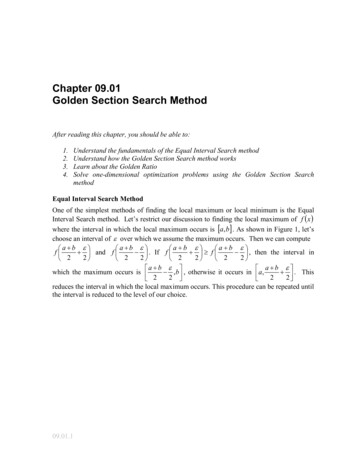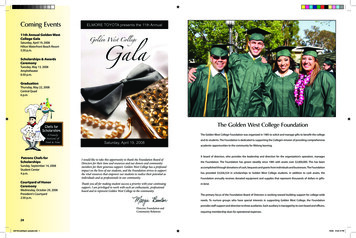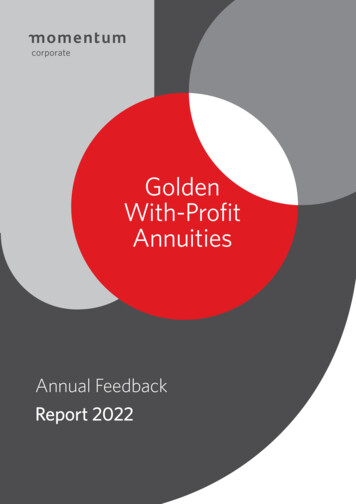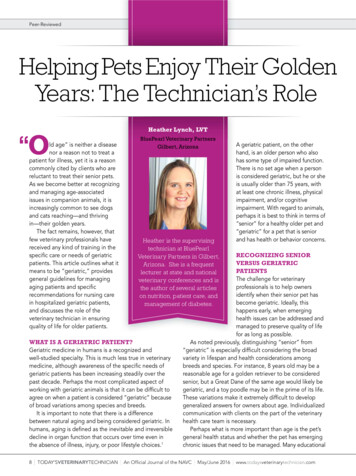
Transcription
Peer-ReviewedHelping Pets Enjoy Their GoldenYears: The Technician’s RoleHeather Lynch, LVT“OBluePearl Veterinary PartnersGilbert, Arizonald age” is neither a diseasenor a reason not to treat apatient for illness, yet it is a reasoncommonly cited by clients who arereluctant to treat their senior pets.As we become better at recognizingand managing age-associatedissues in companion animals, it isincreasingly common to see dogsand cats reaching—and thrivingin—their golden years.The fact remains, however, thatfew veterinary professionals havereceived any kind of training in thespecifc care or needs of geriatricpatients. This article outlines what itmeans to be “geriatric,” providesgeneral guidelines for managingaging patients and specifcrecommendations for nursing carein hospitalized geriatric patients,and discusses the role of theveterinary technician in ensuringquality of life for older patients.Heather is the supervisingtechnician at BluePearlVeterinary Partners in Gilbert,Arizona. She is a frequentlecturer at state and nationalveterinary conferences and isthe author of several articleson nutrition, patient care, andmanagement of diabetes.WHAT IS A GERIATRIC PATIENT?Geriatric medicine in humans is a recognized andwell-studied specialty. This is much less true in veterinarymedicine, although awareness of the specifc needs ofgeriatric patients has been increasing steadily over thepast decade. Perhaps the most complicated aspect ofworking with geriatric animals is that it can be diffcult toagree on when a patient is considered “geriatric” becauseof broad variations among species and breeds.It is important to note that there is a differencebetween natural aging and being considered geriatric. Inhumans, aging is defned as the inevitable and irreversibledecline in organ function that occurs over time even inthe absence of illness, injury, or poor lifestyle choices.18 TODAY’SVETERINARYTECHNICIANVETERINARYA geriatric patient, on the otherhand, is an older person who alsohas some type of impaired function.There is no set age when a personis considered geriatric, but he or sheis usually older than 75 years, withat least one chronic illness, physicalimpairment, and/or cognitiveimpairment. With regard to animals,perhaps it is best to think in terms of“senior” for a healthy older pet and“geriatric” for a pet that is seniorand has health or behavior concerns. RECOGNIZING SENIORVERSUS GERIATRICPATIENTSThe challenge for veterinaryprofessionals is to help ownersidentify when their senior pet hasbecome geriatric. Ideally, thishappens early, when emerginghealth issues can be addressed andmanaged to preserve quality of lifefor as long as possible.As noted previously, distinguishing “senior” from“geriatric” is especially diffcult considering the broadvariety in lifespan and health considerations amongbreeds and species. For instance, 8 years old may be areasonable age for a golden retriever to be consideredsenior, but a Great Dane of the same age would likely begeriatric, and a toy poodle may be in the prime of its life.These variations make it extremely diffcult to developgeneralized answers for owners about age. Individualizedcommunication with clients on the part of the veterinaryhealth care team is necessary.Perhaps what is more important than age is the pet’sgeneral health status and whether the pet has emergingchronic issues that need to be managed. Many educationalAn Offcial Journal of the NAVC May/June 2016 www.todaysveterinarytechnician.com
Helping Pets Enjoy Their Golden Years: The Technician’s RolePhotography by Lars SahlTaking some extratime to interactwith each patientwhile on walks orduring treatmentshelps to allaystress, anxiety,and fear.tools are available to help owners make this distinction(BOX 1), such as an age wheel or a questionnaire aboutpossible age-related changes. The American AnimalHospital Association (AAHA) and American Association ofFeline Practitioners (AAFP) offer senior care guidelines forveterinary professionals that can serve as a great startingpoint for creating practice-specifc senior care informationfor clients:ÆÆAAFP Senior Care df htmlÆÆAAHA Senior Care Guidelines for Dogs and Cats:aaha.org/public ines.pdfAs with humans, prevention, early recognition, andmanagement of health concerns are the best ways toprovide pets with excellent quality of life.TODAY’SVETERINARYTECHNICIANVETERINARY EDUCATED OWNERSARE SUCCESSFUL OWNERSPutting Knowledge into ActionBritish philosopher and sociologist Herbert Spencer oncewrote that, “The great aim of education is not knowledge,but action.”2 To keep older pets healthy for as long aspossible, owners must be able to recognize when it isnecessary for them to act for their pet’s well-being.No matter how good veterinary medicine becomes atdiagnosis and treatment, we still rely on owners—whosee and care for their pets every day—to recognizechanges and seek medical advice on their pets’ behalf.In my opinion, the single most important thingveterinary professionals can do for their patients is toeducate owners to recognize signs of potential healthAn Offcial Journal of the NAVC May/June 2016 www.todaysveterinarytechnician.com 9
Peer-Reviewedconcerns and know when to call or visit their veterinarian.Ideally, this education should begin from the pet’s puppyor kitten visit and continue every year during the patient’sannual veterinary examination.Understanding the Annual ExaminationOver the past several years, the entire veterinarycommunity has been advocating for annual examinations.When it comes to helping owners make the distinctionbetween “normal” aging and initial signs of illness, annualexaminations are important. Many issues that develop overtime and may go unnoticed by pet owners may in fact besigns of an emerging health concern (BOX 2).The American Veterinary Medical Association (AVMA)Partners for Healthy Pets program (partnersforhealthypets.org/) is designed specifcally to help practices develop andpromote the importance of annual examinations to helpimprove compliance. The AAFP, AAHA, and many otherorganizations also offer resources to help the veterinaryteam educate owners about the importance of preventivehealth care. Whether your hospital uses existing resourcesor develops something unique, educating clients aboutthe importance of regular physical examinations by aveterinarian will certainly improve and maintain their pet’squality of life.Many treatment options can be employed at theannual examination to mitigate clinical signs and improvethe patient’s quality of life. Dental prophylaxis, growthremoval, and medical therapy for arthritis or other chronicissues are becoming more routine in senior and geriatricpets. The increase in owner education and willingnessof pet owners to pursue medical care for older petsstrengthens the need for veterinary technicians to gaina fuller understanding of senior and geriatric nursing.TECH PO INT With training, compassion,and proactive pet ownereducation, veterinarytechnicians are integralin helping older pets livelonger with excellentquality of life.NURSING CONSIDERATIONS FORHOSPITALIZED SENIOR OR GERIATRIC PETSPhysical and mental changes associated with aging oftenrequire special nursing care. They may include orthopedicchanges, changes in body condition, and changes inperception or mentation.3 Recognizing health issues thatmay infuence the course of treatment and addressing thoseissues are also important. A nursing plan that proactivelyaddresses these concerns and is appropriate for the patientcan be extremely helpful in improving outcomes.First and foremost in nursing care are the basics: In anyward, all patients should always be clean, warm, and dry.Beyond that, it is important to keep patients moving,ensure their comfort, provide good nutrition, and interactwith them.Fulflling Basic NeedsÆÆMovement: Patients should not be left to lieimmobile in cages or runs for long periods.Movement infuences many body systems, affectingBOX 1 Educating Owners About Their Aging PetsÆ AAHA has produced multiple resources to help put its senior care guidelines into practice, including clientbrochures and a client-facing website about cognitive dysfunction in older pets:aaha.org/professional/resources/senior care.aspx?type resourcesÆ AAFP has produced an excellent brochure for owners of senior dsforLifeBrochure-Purina.pdfÆ The AVMA offers a number of resources for the veterinary team to share with pet owners, including a FAQ,podcasts, and other Older-Pet-FAQs.aspxÆ Veterinary Economics (dvm360.com) offers these downloadable client education tools:Æ Æ Wellness for the older pet (senior wellness testing handout)Æ Æ Behavior screen for dogs and cats (behavior questionnaire that clients can use to prepare for wellness visits)10 TODAY’SVETERINARYTECHNICIANVETERINARY An Offcial Journal of the NAVC May/June 2016 www.todaysveterinarytechnician.com
Helping Pets Enjoy Their Golden Years: The Technician’s Roleblood pressure, gastrointestinal (GI) motility, edema,orthopedic pain, body temperature, and musclestrength. The most obvious way to promotemovement is walking the pet. If walking is not anoption, providing basic physical therapy in the formof passive range of motion exercises, massage, andassisted changes in position (such as standing thepatient up for a short time and then helping thepatient to lie down again) has been shown in humanmedicine to improve outcome and shorten hospitalstays for a variety of medical issues.4,5 Providingeither walks or therapy every 4 hours at a minimum isusually a good starting point in a nursing plan.ÆÆComfort: Senior patients often have lower musclemass and reduced mobility than younger pets. Theymay also have diffculty navigating hard cage or runfoors. Additionally, patients with lower bodycondition scores or those that have friable skin maybe at risk for developing pressure-associated injurieswhen left to lie in a hard cage. Nonslip mats andthicker blanketing may be required to allow thesepatients to rest comfortably. Purpose-built antipressure cage beds are available, but thick blankets,egg crate foam, or other forms of padding canprovide patients with increased comfort.ÆÆNutrition: Senior pets may have GI changes ordisease processes that affect their ability to processnutrients. Loss of lean muscle mass occurs naturallywith aging and may increase with confnement andlack of suffcient nutrients.6 These patients mayrequire a diet adjustment or even a feeding tube ifthey are not able to eat on their own. Recognizingissues that may be interfering with eating, such asnausea, food aversion, or pain, is key in helpingpatients continue to eat voluntarily.ÆÆInteraction and engagement: Hospitalized patientsare often stressed, anxious, and frightened. It isincumbent on veterinary technicians to ease theirdiscomfort, even if that discomfort is more mentalthan physical. Taking some extra time to interact witheach patient while on walks or during treatmentshelps to allay stress, anxiety, and fear. Patients thatfeel comforted by their caregiver often eat better,accept physical therapy and other treatments morereadily, and are more willing to move and walk thanpatients that do not share a bond with their caregiver.Addressing Physical ChallengesPhysical changes related to normal aging in senior andgeriatric patients may pose some challenges to nursing.TODAY’SVETERINARYTECHNICIANVETERINARY ÆÆIncreased skin fragility/friability: Senior patientsmay be at an increased risk for skin tears fromclippers or other instruments. They may also havesmall skin masses or other abnormalities or lesionsthat may be exacerbated by inadequate bedding,clippers, or even restraint. Recognizing these issuesand using extreme care when handling these patientsoften help prevent injury.ÆÆChanges in body condition: Senior patients maypresent in poor body condition. Whether obese orthin, these patients are at risk for developinghospital-induced injuries such as pressure sores,increased stiffness or joint pain, weakness, decreasedmobility, hypothermia, or hyperthermia. Recognizingpoor body condition and providing adequatecushioning (both in cages and on surgery or dentaltables), regular temperature monitoring, andappropriate nutritional support are key.BOX 2 Potential Signs of EmergingDisease in Older Pets3Æ Decreased appetite, with or without weight lossÆ Increased thirstÆ Increased urinationÆ Decreased or no urinationÆ Poor hair coatÆ VomitingÆ Sore mouthÆ Increased urination/spotting “accidents” in thehouseÆ WeaknessÆ CoughingÆ Decreased exercise toleranceÆ Favoring a limbÆ Diffculty sitting or standingÆ Sleeping moreÆ Seeming to have stiff/sore jointsÆ Hesitancy to jump/run or climb stairsÆ Weight gain/weight lossÆ Decreased activity or interest in playÆ Attitude or behavior changes (including increasedirritability)Æ Being less alertAn Offcial Journal of the NAVC May/June 2016 www.todaysveterinarytechnician.com 11
Peer-ReviewedÆÆChanges in perception: Patients with poor eyesightand/or hearing may startle easily or not adapt wellto the hospital environment. They may be injured byfalling or walking off examination tables or cages orbumping into things they are unable to perceive.At times, these pets may be more reactive and maystrike out at their caregivers in the hospital becauseof apprehension about restraint. It is important toproceed slowly with these patients and give themtime to adjust to restraint and/or treatment.ÆÆOrthopedic changes: Almost all senior patientsthat present to a veterinary hospital have somedegree of arthritis or orthopedic issues. Althoughthey may be well tolerated at home, orthopedicissues may be exacerbated in the hospital bymanipulation (e.g., restraining legs for radiography)or long periods of inactivity. The resulting pain maycause the pet to resist handling or to becomefractious. Providing regular walks, physical therapy,and gentle manipulations as well as appropriate paincontrol for these patients helps them better toleratehospitalization and treatments.ÆÆChanges related to organ function and/or chronicdisease: Senior pets are at a higher risk than theiradult counterparts for organ dysfunction, whichmay or may not be evident. Thorough evaluationby the veterinarian, along with diagnostic testing,is important to help the veterinary health care teamrecognize organ dysfunction or chronic diseaseand address its potential effect on the patient’streatment.To achieve optimum results, any of these concernsshould be well communicated and understood by thetechnician providing nursing care. This enables thetechnician to better monitor the patient and recognizechanges that may be signifcant to the veterinarian andthe patient’s treatment plan.7DISCUSSING QUALITY VERSUSQUANTITY OF LIFEThere are myriad theories and opinions about how bestto approach end-of-life care. Many veterinary hospitalsare developing formal hospice care programs to helpowners navigate the end of their pet’s life, includingmaintaining the pet’s quality of life and recognizing whenit has degenerated. The decision to begin hospice careor to euthanize a pet is intensely personal and individual,and every veterinarian has opinions about whatconstitutes appropriate care.12 TODAY’SVETERINARYTECHNICIANVETERINARY TECH PO INT To effect the bestoutcome for seniorand geriatric pets,veterinary techniciansneed to be aware of thechanges that occurwith natural aging andwith chronic health issuesand to address themwhen managing apet’s nursing care.The veterinary technician’s role often becomes oneof providing validation and comfort to the owner. Oneof the most important aspects of this role is havinga thorough understanding of the veterinarian’s andhospital’s policies and procedures so that correct andconsistent information is delivered to clients. Evaluatingquality of life is often subjective and diffcult for owners.In an attempt to provide a standardized evaluation,Dr. Alice Villalobos has developed a Quality of Life Scaleto help owners and veterinarians have these discussions(TABLE 1).8While veterinary technicians are not responsible formaking quality of life determinations, understanding thecriteria that veterinarians are using and being able tosupport the veterinarian’s recommendations help tocomfort owners in the decision-making process.CONCLUSIONSenior patients are becoming a larger segment of thegeneral practice population. Veterinary technicians areoften the primary communicators with owners. As such,technicians shoulder much of the responsibility foreducating and informing clients about their pet’s care.Training and positive messaging about preventivehealth care enables veterinary technicians to be moresuccessful in gaining owner compliance. Proactivelycommunicating with owners of young pets about thepet’s ongoing preventive health care needs, appropriatehome care, and early signs of illness gives owners theAn Offcial Journal of the NAVC May/June 2016 www.todaysveterinarytechnician.com
Educatingclients about theimportance ofregular physicalexaminations by aveterinarian willcertainly improveand maintain theirpet’s qualityof life.Shutterstock.com/Bruce WeberHelping Pets Enjoy Their Golden Years: The Technician’s RoleTABLE 1The HHHHHMM Quality of Life ScaleEvaluate each of the following areas on a scale of 0 to 10, with“0” being unacceptable and “10” being ideal. A total score of35 or higher is considered an acceptable score for quality of life.SCORE(0–10)CRITERIONHurt: Is the pet receiving adequate pain control(including breathing ability)?Hunger: Is the pet eating enough on its own? Doesthe pet require hand feeding or tube feeding?Hydration: Is the pet hydrated? Does it needsubcutaneous fuids?Hygiene: Is the pet brushed and cleaned regularly,especially after elimination?Happiness: Does the pet express joy or interest?Does it respond to its environment? Does the petshow signs of boredom, loneliness, anxiety, or fear?Mobility: Can the pet get up without assistance?Does the pet want to go for a walk? Is the petexperiencing seizures or stumbling?More Good Than Bad: Do good days outnumberbad days?Total Score:Adapted from Villalobos and Kaplan.8TODAY’SVETERINARYTECHNICIANVETERINARY tools they need to avoid some problems, identify healthconcerns when they occur, and seek appropriate care.To effect the best outcome for senior and geriatric pets,veterinary technicians need to be aware of the changesthat occur with natural aging and with chronic health issuesand to address them when managing a pet’s nursing care.With training, compassion, and proactive pet ownereducation, veterinary technicians are integral in helpingolder pets live longer with excellent quality of life. References1. Besdine RW. Introduction to geriatrics. 2013. Merck Manuals website (professionalversion). -geriatrics. Updated July 2013. Accessed January 2016.2. Spencer H. Essays on Education and Kindred Subjects. 2005. Project Gutenbergwebsite. gutenberg.org/fles/16510/16510-h/16510-h.htm. Accessed January 2016.3. Epstein M, Kuehn NF, Landsberg G, et al. AAHA senior care guidelines for dogs andcats. JAAHA 2005;41:81-91.4. Valenza DG, Valenza MC, Cabrera-Martos I, et al. The effects of a physiotherapyprogramme on patients with a pleural effusion: a controlled trial. Clin Rehabil 2014;28(11):1087-1095.5. Labraca NS, Castro-Sanchez AM, Mataran-Panarrocha GA, et al. Benefts of startingrehabilitation within 24 hours of primary total knee arthroplasty: randomized clinicaltrial. Clin Rehabil 2011;25(6):557-566.6. Churchill JA. Nutrition for senior dogs: new tricks for feeding old dogs. In: CriticalUpdates on Canine & Feline Health. 2015 NAVC/WVC Symposia Proceedings.2015. ents/Nutrition%20for%20Senior%20Dogs.pdf. Accessed March 2016.7. Pittari J, Rodan I, Beekman, G, et al. American Association of Feline Practitionerssenior care guidelines. J Feline Med Surg 2009;11:763-778.8. Villalobos A, Kaplan L. Palliative care: end of life “pawspice” care. In Canine andFeline Geriatric Oncology: Honoring the Human-Animal Bond. Ames, IA: BlackwellPublishing, 2007, Table 10.1.An Offcial Journal of the NAVC May/June 2016 www.todaysveterinarytechnician.com 13
Years: The Technician's Role Heather Lynch, LVT BluePearl Veterinary Partners Gilbert, Arizona Heather is the supervising technician at BluePearl Veterinary Partners in Gilbert, Arizona. She is a frequent lecturer at state and national veterinary conferences and is the author of several articles on nutrition, patient care, and management of .
